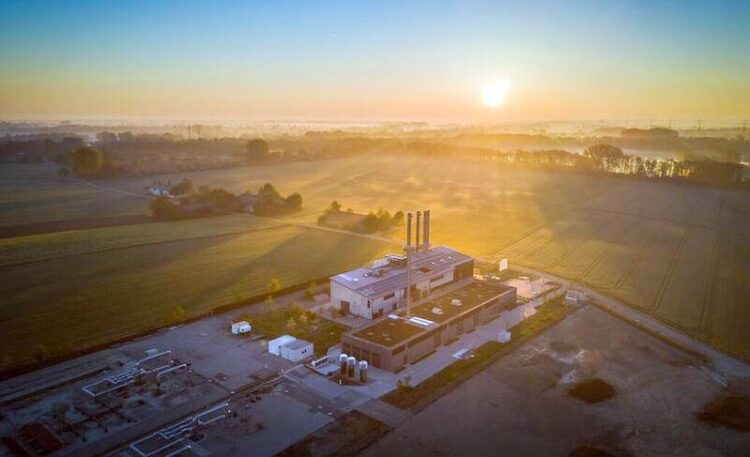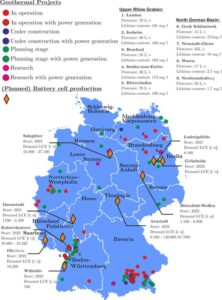Limits of lithium extraction from thermal water

A geothermal power plant at Unterföhring near München.
Credit: Stephan Kelle 2016, https://www.geovol.de/
A KIT team has analyzed the extraction of lithium from thermal water resources in Germany – feasible extraction volumes and time horizon limit the potential.
Pumping up thermal water, separating lithium, and using it to produce batteries for electric mobility – the idea of lithium as an environmentally compatible and regionally available by-product of geothermal energy plants appears highly promising. However, it has not been clear so far whether domestic lithium extraction is really worthwhile. A team of researchers from Karlsruhe Institute of Technology (KIT) has now summarized the state of the art, analyzed raw materials markets, and assessed technologies. According to them, it might be possible in theory to extract thousands of tons of lithium every year in Germany, but crucial aspects still need to be clarified.
For the energy transition, Europe needs a lot of batteries and sufficient lithium to produce them. The European Union (EU) accordingly classifies lithium as a critical resource. There is a danger of a lithium shortfall. “We are entirely dependent on imports. Worldwide, 80 percent of lithium resources come from Chile and Australia,” says Valentin Goldberg from KIT’s Institute of Applied Geosciences (AGW). “At the same time, we deliberately accept major environmental expenses due to the conventional extraction of lithium in these countries, including negative impacts on groundwater.” Lithium extraction in geothermal power plants, by contrast, is planned to be based on existing infrastructure in Europe, where large volumes of thermal water with a sometimes high lithium concentration are being extracted. Following energy production, lithium will be separated and the remaining water will be fed back into the underground, as usual during operation. “In principle, we are very positive about this technology. Hardly any space would be needed, environmental and transportation costs would be low,” Goldberg says. To realistically determine the potential future share of domestic lithium, Goldberg and his colleagues from AGW have collected the available knowledge, analyzed it, and for the first time calculated the potential for Germany.
Regional Lithium Extraction for Complementing Resources in an Environmentally Friendly Way

Geothermal power plants with lithium concentrations and flow rates and planned battery cell production facilities in Germany.
Credit: Goldberg et al. 2022
The potential lithium extraction volume does not only depend on the water’s lithium concentration, but also on the location-dependent flow rate and reservoir dimension. For their estimations, the researchers analyzed potential locations in Germany, studied markets of raw materials, and assessed various technologies in terms of efficiency, applicability, and integration in geothermal energy production. “On this basis, we have obtained an optimistic annual production estimate of about 2600 to 4700 tons lithium carbonate equivalent, provided that all relevant geothermal energy plants are equipped with the necessary systems,” says Dr. Fabian Nitschke, AGW, who was also involved in the studies. “With this, we could cover about 2 to 13 percent of the annual quantity needed for planned battery production in Germany.” Construction of additional geothermal power plants might increase the extraction volumes. However, it will take at least five years for a newly planned power plant to start operation.” In view of the predicted global lithium shortfall and planned battery production, the situation in Germany will deteriorate soon. For this reason, lithium from geothermal power plants will nothing but complement imported resources in the medium term,” Nitschke says.
Direct Comparison of Different Technologies
Prognoses still are subject to many uncertainties: The dimensions and the origins of lithium resources in geothermal systems as well as the response of the reservoirs to continuous extraction are being studied at the moment. Moreover, extraction technologies are far from mature – essential development processes and long-term tests remain to be carried out. “But direct comparison already reveals specific advantages and drawbacks that are of particular relevance to economically efficient lithium extraction,” says Dr. Tobias Kluge, AGW, another author of the study. “The need for additional resources, damage caused by deposits in boreholes and extraction units, and energy consumption directly affect economic efficiency.”
Wide Public Acceptance Is Required
Still, it is not further technology development or suitable locations that will decide on whether lithium will be extracted at German geothermal power plants. Public support and acceptance will be required, Valentin Goldberg emphasizes. “Our publications in the journal “Grundwasser” (groundwater) do not only address experts. We rather want to give decision-makers in politics and industry as well as the interested public the chance to inform themselves directly and independently about opportunities and challenges.” Now, the findings can be used as a basis for future research and development in this area. The studies were carried out within the framework of the geoenergy research activity coordinated by the Geothermal Energy and Reservoir Technology Group of AGW within the Helmholtz Research Field Energy and the BrineMine Project funded by the Federal Ministry of Education and Research (BMBF).(mhe)
Original Publications
Goldberg, V., Kluge, T., Nitschke, F.: Herausforderungen und Chancen für die Lithiumgewinnung aus geothermalen Systemen in Deutschland Teil 1: Literaturvergleich bestehender Extraktionstechnologien. Grundwasser. (2022)(a) https://doi.org/10.1007/s00767-022-00522-5
Goldberg, V., Nitschke, F., Kluge, T.: Herausforderungen und Chancen für die Lithiumgewinnung aus geothermalen Systemen in Deutschland Teil 2: Potenziale und Produktionsszenarien in Deutschland. Grundwasser – Zeitschrift der Fachsektion Hydrogeologie (2022)(b). https://doi.org/10.1007/s00767-022-00523-4
More about the KIT Energy Center: https://www.energie.kit.edu/
Being “The Research University in the Helmholtz Association”, KIT creates and imparts knowledge for the society and the environment. It is the objective to make significant contributions to the global challenges in the fields of energy, mobility, and information. For this, about 9,800 employees cooperate in a broad range of disciplines in natural sciences, engineering sciences, economics, and the humanities and social sciences. KIT prepares its 22,300 students for responsible tasks in society, industry, and science by offering research-based study programs. Innovation efforts at KIT build a bridge between important scientific findings and their application for the benefit of society, economic prosperity, and the preservation of our natural basis of life. KIT is one of the German universities of excellence.
DOI: 10.1007/s00767-022-00522-5
Method of Research: Data/statistical analysis
Subject of Research: Not applicable
Article Title: Challenges and opportunities for lithium extraction from geothermal systems in Germany—Part 1: Literature review of existing extraction technologies
Article Publication Date: 23-Sep-2022
Media Contact
All latest news from the category: Earth Sciences
Earth Sciences (also referred to as Geosciences), which deals with basic issues surrounding our planet, plays a vital role in the area of energy and raw materials supply.
Earth Sciences comprises subjects such as geology, geography, geological informatics, paleontology, mineralogy, petrography, crystallography, geophysics, geodesy, glaciology, cartography, photogrammetry, meteorology and seismology, early-warning systems, earthquake research and polar research.
Newest articles

First-of-its-kind study uses remote sensing to monitor plastic debris in rivers and lakes
Remote sensing creates a cost-effective solution to monitoring plastic pollution. A first-of-its-kind study from researchers at the University of Minnesota Twin Cities shows how remote sensing can help monitor and…

Laser-based artificial neuron mimics nerve cell functions at lightning speed
With a processing speed a billion times faster than nature, chip-based laser neuron could help advance AI tasks such as pattern recognition and sequence prediction. Researchers have developed a laser-based…

Optimising the processing of plastic waste
Just one look in the yellow bin reveals a colourful jumble of different types of plastic. However, the purer and more uniform plastic waste is, the easier it is to…



